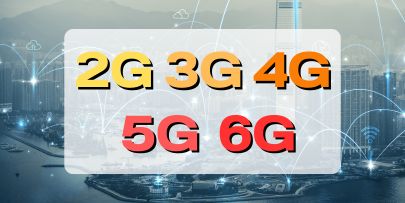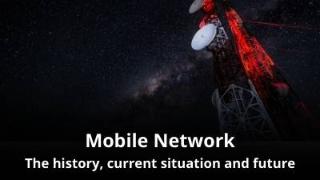The History, Current situation, and Future outlook of the Mobile Networks.
Understanding the history, current situation, and future outlook of different mobile networks generations (2G, 3G, 4G, 5G, and future generations) is crucial when setting up your Mobile Virtual Network Operator (MVNO).
Let’s investigate the following points:
- Why History, Current Situation, and Future Outlook Matter for your MVNO?
- What is the history, current situation, and future of the different mobile networks?
- What is the history, current situation, and future of the 2G (Second Generation) mobile network?
- What is the history, current situation, and future of the 3G (Third Generation) mobile network?
- What is the history, current situation, and future of the 4G (Fourth Generation) mobile network?
- What is the history, current situation, and future of the 5G (Fifth Generation) mobile network?
- What is the history, current situation, and future of the 6G (Sixth Generation) mobile network?
- Summary of the History, Current situation, and Future of the mobile networks
- Frequently Asked Question (FAQs)
Why History, Current Situation, and Future Outlook Matter for your MVNO?
Technology Selection
Understanding the history and status of mobile networks helps you choose the right technology for your MVNO based on the existing infrastructure and customer demands.
Service Offerings
Keeping an eye on the future of mobile networks allows your MVNO to plan for innovative services, ensuring you stay ahead of the competition and meet evolving customer needs.
Partnerships and Alliances
Being aware of upcoming technologies enables strategic partnerships with network operators and technology providers, fostering mutually beneficial relationships.
Investment Decisions
Knowledge of the mobile network landscape aids informed investment decisions, ensuring your MVNO allocates resources efficiently for long-term sustainability.
Customer Expectations
Understanding the advancements in mobile networks helps you anticipate customer expectations, enabling you to provide services that align with their evolving needs and preferences.
What is the history, current situation, and future of the different mobile networks?
Here’s a detailed overview of each generation and its significance for your MVNO:
- What is the history, current situation, and future of the 2G (Second Generation) mobile network?
- What is the history, current situation, and future of the 3G (Third Generation) mobile network?
- What is the history, current situation, and future of the 4G (Fourth Generation) mobile network?
- What is the history, current situation, and future of the 5G (Fifth Generation) mobile network?
- What is the history, current situation, and future of the 6G (Sixth Generation) mobile network?

What is the history, current situation, and future of the 2G (Second Generation) mobile network?

History
2G networks were introduced in the 1990s, marking the shift from analog to digital communication. They enabled digital encryption, allowing for secure voice calls and text messaging.
Current Situation
While 2G is considered outdated for data-intensive applications, it still provides reliable voice and basic text services, especially in remote or developing regions. However, it is already being phased out in several countries.
Future Outlook
2G networks will be fully phased out in many parts of the world, making room for newer technologies. However, it might be that they (still) remain essential for basic communication needs in certain areas.
What is the history, current situation, and future of the 3G (Third Generation) mobile network?

History
3G networks emerged in the early 2000s, offering faster data speeds than 2G. They facilitated mobile internet, video calls, and multimedia messaging.
Current Situation
3G networks are still operational in many regions, providing moderate data speeds. They are being gradually replaced by 4G and 5G technologies.
Future Outlook
3G networks are being decommissioned in favor of faster and more efficient technologies. MVNOs should consider transitioning away from 3G to offer better services to customers.
What is the history, current situation, and future of the 4G (Fourth Generation) mobile network?

History
4G networks, specifically LTE (Long-Term Evolution), were introduced in the late 2000s, offering significantly faster data speeds, low latency, and enhanced multimedia capabilities.
Current Situation
4G networks are widely deployed globally, providing high-speed internet, online gaming, HD video streaming, and real-time applications.
Future Outlook
While 4G continues to serve as a reliable technology, it is gradually making way for 5G networks in many regions. However, 4G will remain relevant for several years, especially in areas where 5G infrastructure is still developing.
What is the history, current situation, and future of the 5G (Fifth Generation) mobile network?

History
5G networks began commercial deployment in 2019, introducing ultra-high speeds, minimal latency, and support for emerging technologies like IoT, AR, and VR.
Current Situation
5G networks are expanding globally very fast, offering multi-Gbps speeds, enabling real-time applications, remote surgeries, autonomous vehicles, and advanced industrial automation.
Future Outlook
5G technology continues to evolve, focusing on enhancing network efficiency, expanding coverage, and enabling futuristic applications. MVNOs should consider adopting 5G to offer cutting-edge services and stay competitive.
What is the history, current situation, and future of the 6G (Sixth Generation) mobile network?

History
6G is the future technical standard of a sixth-generation technology for wireless communications.
Current Situation
Lab testing & pilots are expected to begin in 2028, commercial near 2030
Future Outlook
6G networks are currently in the research phase, aiming to provide terabit speeds, support for holographic communication, advanced AI, and seamless connectivity in extreme environments. 6G internet is expected to launch commercially in 2030.
Significance for Your MVNO: While 6G is not yet widely available, staying updated on its developments can help your MVNO prepare for the future. Understanding the potential of 6G enables strategic planning for innovative services and partnerships.
Summary of the History, Current situation, and Future of the mobile networks
By considering the history, current situation, and future outlook of mobile networks, your MVNO can make strategic decisions that align with market trends, technological advancements, and customer expectations, ensuring a competitive edge and long-term success in the telecommunications industry.
Frequently Asked Questions (FAQs)
When will 6G mobile networks be commercially available?
Commercial deployment of 6G networks is expected to begin near 2030, with lab testing and pilots likely starting around 2028.
Is 2G still relevant for MVNOs today?
While 2G is outdated for data, it remains essential in some remote regions for basic voice and text services. However, MVNOs must prepare for its full phase-out globally.
What are the main benefits of 5G for an MVNO?
5G offers ultra-high speeds, minimal latency, and massive capacity for IoT, AR/VR, and advanced industrial applications, allowing MVNOs to offer cutting-edge services.
Why are 3G networks being decommissioned?
3G networks are being decommissioned to reallocate spectrum for faster and more efficient 4G and 5G technologies.
How long will 4G LTE remain relevant?
4G will remain relevant for several years to come, especially in areas where 5G infrastructure is still maturing, serving as a reliable backbone for mobile services.
What future technologies will 6G support?
6G aims to support terabit speeds, holographic communication, advanced AI integration, and seamless connectivity in extreme environments.








